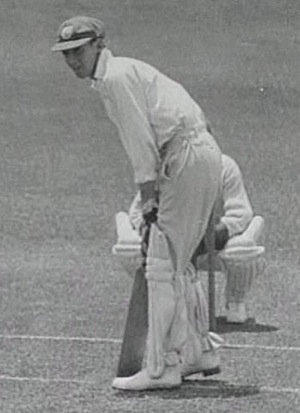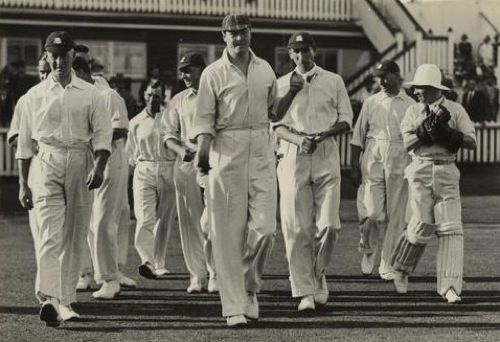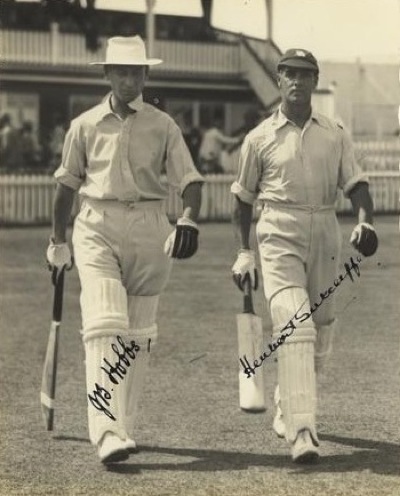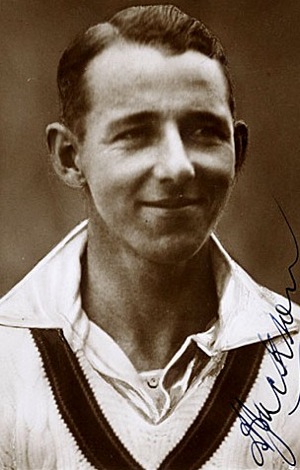Click here to print
Historic Cricket Footage Found in a Shed
posted December 22, 2010

The biggest deal in international cricket is the oddly titled Australia v England series, The Ashes. It has been taking place generally every second year, alternating from one country to the other, since 1882.
Thanks to an English family’s discovery of a forebear’s home movie, images have now emerged of some of the most famous players in the history of the contest, during England’s tour of Australia during the southern summer of 1928-29.
A passionate, dogged, and often snarling affair, the Ashes has had its share of legendary players, and arguably none greater than “The Don,” Donald Bradman, later Sir Donald Bradman, a boy from the New South Wales bush who would be the indisputable greatest batsman in the game from the late 1920s until his retirement in 1948. (That year, he led the Australian team to England where it would go undefeated and earn the name “The Invincibles”).
Only a handful have challenged his stature, since.
Recently, while cleaning a garage, the descendant of an English player of the 1920s, Percy Fender, discovered his forebear’s 30-minute travelogue film of that tour, and it includes images of Bradman in his youth, as he prepared for his first participation with the Australian national team, and as he then takes part in the Ashes campaign. (A news feature about the film can be viewed until the end of this year 2010, on the website of the Australian Broadcasting Corporation’s 7:30 Report; after that time, a transcript will remain available at that site.)

It boasted Wally Hammond, the world’s leading batsman of the day. During the series (which always consists of five “test matches,” each of five days’ duration), he made two double centuries (a comparable feat in baseball might be scoring, say, seven home runs in ten at bats), including a classic innings in Sydney that would be talked about for decades. He scored an awesome 903 runs during the series.
And he was not the only stand-out English player on that team. Also on board were Jack Hobbs, Herbert Sutcliffe, Douglas Jardine, and Harold Larwood, all all-time greats of the game.
Percy Fender, who had represented England throughout the 1920s, made his 30-minute film of that tour while touring with it as a reporter and as an author planning to write a book about the series. He brought along a home-movie camera, a rare commodity at the time. The footage he made, and that has now been found by his descendants, is of considerable interest in the world of cricket, particularly Australian cricket, because it includes the earliest-known moving images of Donald Bradman.
Also in the film are shots of another legendary player making his international debut, Archie Jackson.

He also shot footage of the Melbourne Cup, run since 1861 on the first Tuesday in November, occasioning what is surely the world’s only public holiday for a horse race. And he ventured on Christmas Day to Sydney’s Bondi Beach, long Sydneysiders’ go-to place on Christmas afternoons.
The images of Bradman and Jackson are arguably the most noteworthy moments of Fender’s film. The young New South Wales stars were making their test-match debuts that season. And Fender’s were the first-ever moving images of them. The 20-year old Bradman would soon become the greatest batsman of all time. And his debut season was auspicious. He scored 112, his first century, during the third test, at the Melbourne Cricket Ground. In Fender’s film he already displays the conservative but imperious, near-invincible style that would take him to enormous fame.
Also shown is the attractive, flowing, risk-taking batting style of the 19-year-old Jackson, a Scottish-born migrant to Australia who at the time was compared to Bradman, and who made a memorable 164 runs in one innings at the fourth test, in Adelaide. The innings so exhausted him that teammates feared for his health. And indeed they should have. He was suffering from early stages of tuberculosis, an illness that sapped his strength during the Australian team’s next tour of England, in 1930, where Jackson struggled to breathe.
During that 1930 tour, Bradman flourished. He broke many records and scored an unprecedented 974 runs at an average of 139, a stunning sustained performance. In the last of the series’ five test matches, he and Jackson teamed up in a stellar 243-run partnership that won the game for Australia and brought the Ashes home. The two batsman amassed their runs in the face of hostile bowling from Harold Larwood. Jackson survived the barrage to make 73 runs while Bradman amassed 232.
But by the time the England team toured Australia again, in 1932-33, for the infamous “bodyline” series in which English bowlers targeted Bradman’s body with short-pitched, rising balls, Jackson was deathly ill. He died not far from the Brisbane ground where the fourth test match of the series, in which England re-took the Ashes, was played.

Percy Fender’s grandson, Guy Fender, discovered the 1928-29 film while clearing out his garage in Taunton, England. It was in a dusty film canister labelled ‘cricket’. The family had long ago forgotten the film existed, in part because Percy Fender never mentioned it in his book about the series, The Turn of the Wheel.
Fender has sent a copy of his forebear’s film to the Bradman Museum in “The Don’s” hometown, Bowral, New South Wales. The footage is also being incorporated into a documentary film being made in England.
[The film is available online, courtesy of the Vera/Percy Fender Estate, although this link, originally posted by The Guardian newspaper in England, has proven undependable.)
Printed from Moving Image Archive News: http://www.movingimagearchivenews.org
URL to article: http://www.movingimagearchivenews.org/historic-cricket-footage-found-in-a-shed/
Click here to print